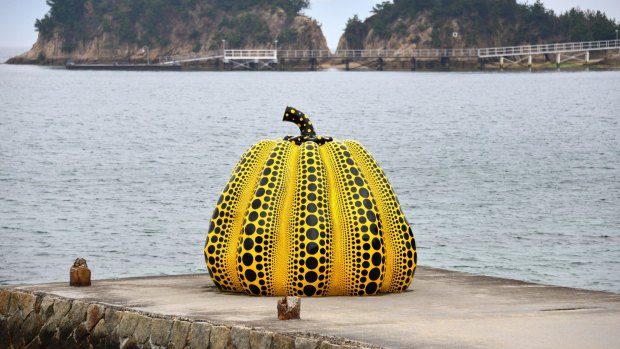This was published 2 years ago
Yayoi Kusama's iconic pumpkin sculpture in Naoshima, Japan washed into sea by storm
By Michelle Ye Hee Lee

The Yellow Pumpkin, an installation art by Yayoi Kusama is displayed at Naoshima Island in Japan.Credit: Alamy
Japanese artist Yayoi Kusama's iconic, polka-dotted yellow pumpkin sculpture on the island of Naoshima was dislodged Monday due to strong winds and high tide from a typhoon, and has been removed for restoration, the art exhibit confirmed.
Typhoon Lupit made landfall Sunday night in Southwestern Japan, where Naoshima is located, bringing heavy rain and stormy winds throughout Monday.
Videos surfaced on social media of Kusama's "Pumpkin" swept away from the pier, flipped over and tumbling on the shore as waves tossed it around.
Benesse Art Site, the exhibit that houses "Pumpkin," confirmed on Monday afternoon in a tweet that the sculpture was damaged by the typhoon and was removed so that it can be restored. The exhibit said it would make an announcement once the artwork is on display again.
The "Pumpkin" located on the tip of the pier in Naoshima remains one of the most recognised images of the island, with its vibrant yellow and black polka dots juxtaposed with the bright blue water in the background.
Since it was installed in 1994, the "Pumpkin" has become an iconic staple of the Benesse Art Site of Naoshima, also known as Japan's art island known for its modern art museums and architecture, and displays of modern sculpture and installations around the island. The sculpture is about two metres tall and just under 2.5 metres wide. It was one of the largest pumpkins that Kusama, known for her colourful shapes and patterns, had made at the time, and was her first open-air sculpture, according to the Benesse Art Site Naoshima.
Kusama then went on to create open-air sculptures, mainly pumpkins, in cities throughout the world. Pumpkins are a source of "radiant energy" and "inspiration for the artist since her childhood, when she was surrounded by her family's seed nursery in prewar Japan," according to the Smithsonian.
The yellow pumpkins were prominently featured in Kusama's 2017 "Infinity Mirrors" exhibition at the Hirshhorn Museum in Washington, and a version of the "Pumpkin" was on display outside of the museum throughout the course of the exhibition.
The "Pumpkin" has been temporarily relocated in advance of a typhoon to preserve it from potential damage. An Instagram video posted in 2019 by the account of Guesthouse Umikko, located near the art display, showed workers manually lifting the pumpkin and transporting it on the back of a truck before a typhoon.
On Monday, however, it appeared that winds and waves picked up unexpectedly. Several staff members of the art exhibit had watched the waves take over the sculpture when there was high tide, according to local media.
The Washington Post
Sign up for the Traveller Deals newsletter
Get exclusive travel deals delivered straight to your inbox. Sign up now.